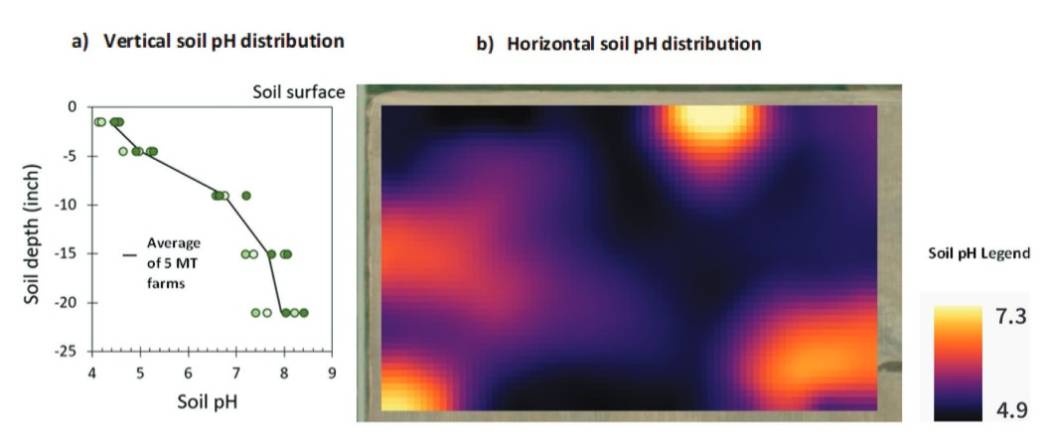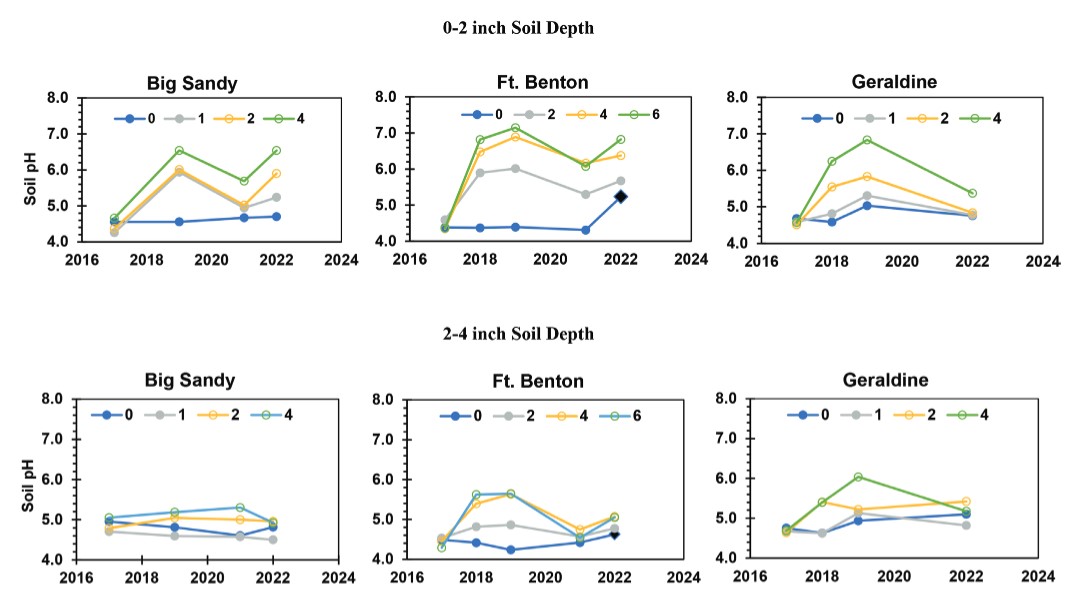Lime Management to Increase Soil pH in Semi-Arid Regions of the U.S.
Manbir Rakkar, The Ohio State University; and Clain Jones, Perry Miller, Kent McVay,
and Richard
Engel, Montana State University
This article was originally published in 2024 in the American Society of Agronomy's Crops and Soils Magazine, contributed by the Western Region Nutrient Management Coordinating Committee (WERA-103). A printable PDF version of this article is also available.
Soil acidification, a common issue in high-rainfall areas of the U.S. and Canada, has become a more prevalent problem in the semi-arid areas of the western U.S. Liming is an effective way to mitigate soil acidity as the carbonate reacts with hydrogen ions in the soil solution to increase the soil pH. However, questions exist about the type of liming product, lime rate, cost effectiveness, and how long the lime benefits last, especially in regions that have historically not needed lime, like much of the Great Plains. Earn 0.5 CEUs in Soil & Water Management by reading the article and taking the quiz at https://web.sciencesocieties.org/Learning-Center/Courses.
Introduction
Soil acidification, a common issue in high-rainfall areas of the U.S. and Canada,
has become a more prevalent problem in the semi-arid areas of the western U.S. In
Montana alone, 24 of 56 counties have at least one
cropland field with a soil pH less than 5.5, and there are likely at least 500,000
acres below that pH. Most of these locations are under wheat production. The likely
cause of the acidity is nitrification of ammonium-based fertilizers (e.g., urea),
which have seen tremendous application increases since 1985 to obtain protein premiums
and increase crop yields.
Low pH dissolves a portion of naturally occurring soil aluminum, which is highly toxic to crops. Other negative effects of soil acidity include reduced activity of nitrogen-fixing bacteria in legumes, increased fungal diseases, herbicide persistence, and low nutrient availability. While prevention is the key to avoiding soil acidity, mitigation strategies are needed to raise the soil pH when low pH causes unacceptable crop losses.
Liming is an effective way to mitigate soil acidity as the carbonate reacts with hydrogen
ions in the soil solution to increase the soil pH. However, questions exist about
the type of liming product, lime rate, cost effectiveness, and how long the lime benefits
last, especially in regions that have historically not needed lime, like much of the
Great Plains.
Accurate pH Characterization for Variable-Rate Lime Application
The first step in mitigation is to accurately characterize the soil pH. Soil pH varies both vertically and horizontally. Based on data from Montana, soil pH is considerably lower near the soil surface and can vary from 4.9 to 7.3 even within a 50-ac field (Figure 1). The results have implications for accurately detecting the extent of soil acidity and preparing a lime management plan.
 Figure 1. An example of (a) vertical pH distribution across five farms (Jones et al.,
2019) and (b) horizontal pH distribution across a 50-ac grower’s field near Billings,
MT (courtesy Paul Nugent).
Figure 1. An example of (a) vertical pH distribution across five farms (Jones et al.,
2019) and (b) horizontal pH distribution across a 50-ac grower’s field near Billings,
MT (courtesy Paul Nugent).
It is recommended to grid or zone sample, rather than composite soil across fields,
and collect soil samples from 0 to 3 inches instead of 0 to 6 inches to better detect
areas with low soil pH. Such sampling schemes would provide the data for site-specific
liming to save money. Grid sampling could be labor and time intensive. Preliminary
data from Montana indicate some good potential of using remote sensing or on-the-go
sensor technology such as Veris (MSP3, Veris Technologies, KS) to detect soil pH variability
(Nugent et al., unpublished data).
Liming Products and Mode of Application
Liming products vary in their composition, mesh size, cost, and feasibility of application.
Sugarbeet
lime is a by-product of the sugar industry and is freely available but can cost up
to $145/ac when considering the hauling cost to around 250 miles and high rates needed
(up to 4 ton/ac). Sugarbeet lime application also requires special spreading equipment,
which can cost about $60,000 for large variable-rate spreaders. Other products are
prilled or pelletized lime, which can cost $250 to 300/ton, and aglime, which costs
around $55/ton, excluding shipping and application cost.
We examined the efficacy of different liming products (aglime, sugarbeet lime, and prilled lime) and method of application (incorporated with tillage, surface-applied with no-till, and seed-drilled). The application rate of aglime and sugarbeet lime was determined based on calcium carbonate equivalent and buffer test, targeting a pH of 6.2 (1–4 tons lime/ac), whereas prilled lime rate was 250 lb/ac based on the feasibility to utilize a seed drill.
The results indicated that incorporating sugarbeet lime is the most effective way
of raising soil pH, but no-till beet lime also increased the pH levels into the optimum
pH zone (6.5–7.5) in this 2023 study (Figure 2). Growing season precipitation was
much higher in 2023 than most years, which likely helped move beet lime in the no-till
treatment. The results suggest that freely available lime products (e.g., sugarbeet
lime) are as, or more, effective as costly lime products (e.g., aglime) to raise soil
pH. Prilled lime, which was seed-drilled (250 lb/ac) to investigate as an option for
no-till farmers, was not an effective strategy to raise pH or improve crop yields.

Figure 2. Soil pH under different liming products and modes of application at two sites in Montana in fall 2023. Application of products and tillage occurred in fall 2022 except seed-drilling of prilled lime, which was done in spring 2023.
How Long Do Lime Benefits Last in Semi-Arid Environment?
A study from Saskatchewan indicated that a single application of lime improved soil
pH and crop yields for 16 to 27 years (Malhi et al., 1995). However, the duration
of lime impacts in somewhat warmer and drier environments is relatively unknown. We
tested the efficacy of different lime rates (0 to 4 ton/ac) to raise pH at three on-farm
sites
in Montana over a five-year period (Figure 3). Sugarbeet lime was applied in fall
2017. The application of lime increased the soil pH at all sites at the 0- to 2-inch
soil depth; however, by 2022, pH decreased from the 2019 peak at all sites except
Big Sandy (Figure 3). A drop in pH below 5.5 at Geraldine indicates that re-application
of lime could be needed after five years to raise pH to the optimum pH zone at least
in some soils. At the other two sites, even though surface pH was above 6, pH at 2
to 4 inches was below 5.5, which could negatively affect the crop growth. It is important
to consider that 2 to 4 inches is in, or directly below, the seeding zone; therefore,
an optimum pH could be critical in that soil zone.

Figure 3. Soil pH at the 0- to 2- and 2- to 4-inch soil depth under four lime rates over five years at three sites in Montana. Lime was applied in fall 2017 without tilling at Big Sandy with vertical tillage at Fort Benton and with intensive tillage at the Geraldine site. At Fort Benton, the diamond mark indicates the 0 tons/ac treatment that received 2 tons/ac lime after 2021 sampling, which increased soil pH in 2022.Numbers in the legend are beet lime rates in wet tons per acre.
The highest rate at each site (4 or 6 tons/ac) increased soil pH the most whereas 1 and 2 tons/ac were not able to keep the soil pH in the optimum zone by 2022 at two of the sites, even in the upper 2 inches. At the Big Sandy site where lime was not tilled, no pH increase occurred at 2 to 4 inches over the five-year period, demonstrating that there is not enough moisture to dissolve and move lime below 2 inches in a low annual precipitation zone (14 inches). This is a disappointing finding given the importance of no- till at reducing wind erosion losses and conserving moisture. This stresses the importance of catching low soil pH before it becomes a problem as liming is expensive and requires tillage to be effective in dry environments prone to wind erosion.
Summary/Takeaways
1. Precise soil pH monitoring is required to detect soil acidity issues; compositing soil samples across field landscapes and soil depths can mask the issue.
2. Site-specific lime management can reduce lime costs to growers and avoid application to high-pH areas.
3. Freely available products such as sugarbeet lime could be as, or more, effective as costly products such as aglime and prilled lime.
4. Lime may need to be re-applied after five years under semi-arid environments to keep the soil pH in the optimum zone of 6.5 to 7.5.
References
Jones, C., Engel, R., & Olson-Rutz, K. (2019). Soil acidification in the semiarid regions of North America’s Great Plains. Crops & Soils, 52(2), 28–56. https://doi.org/10.2134/cs2019.52.0211
Malhi, S.S., Mumey, G., Nyborg, M., Ukrainetz, H., & Penney, D.C. (1995). Longevity of liming in western Canada: Soil pH, crop yield and economics. In R.A. Date, N.J. Grundon, G.E. Rayment, M.E. Probert (Eds.), Plant–soil interactions at low pH: principles and management (pp. 703–710). https://doi.org/10.1007/978-94-011-0221-6_112
